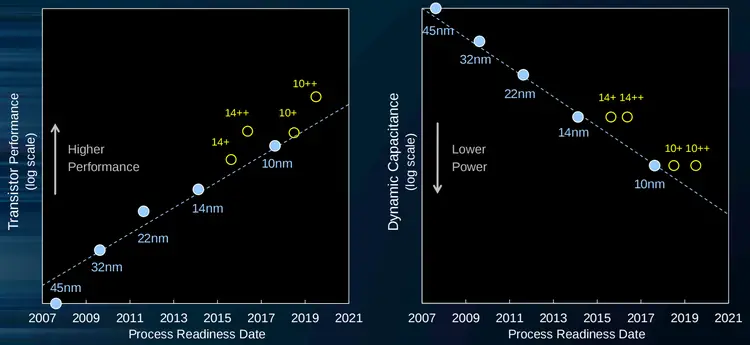From WikiChip
Difference between revisions of "intel/microarchitectures/ice lake (client)"
(https://xdc2018.x.org/slides/Manasi_XDC_2018_final.pdf) |
|||
| Line 87: | Line 87: | ||
** {{intel|UHD Graphics P730}} '''→''' {{intel|UHD Graphics P830}} (64 Execution Units, 1.6x EUs from {{\\|Cannon Lake}}) | ** {{intel|UHD Graphics P730}} '''→''' {{intel|UHD Graphics P830}} (64 Execution Units, 1.6x EUs from {{\\|Cannon Lake}}) | ||
* Display | * Display | ||
| − | ** DisplayPort 1.4a | + | ** DisplayPort 1.4a with Display Stream Compression(DSC) (from 1.2) |
====New instructions ==== | ====New instructions ==== | ||
Revision as of 12:59, 2 October 2018
| Edit Values | |
| Ice Lake (client) µarch | |
| General Info | |
| Arch Type | CPU |
| Designer | Intel |
| Manufacturer | Intel |
| Introduction | 2018 |
| Process | 10 nm |
| Instructions | |
| ISA | x86-64 |
| Cores | |
| Core Names | Ice Lake S |
| Succession | |
| Contemporary | |
| Ice Lake (server) | |
Ice Lake (ICL) Client Configuration is Intel's successor to Cannon Lake, a 10 nm microarchitecture for mainstream workstations, desktops, and mobile devices.
Contents
Codenames
| Core | Abbrev | Description | Graphics | Target |
|---|---|---|---|---|
| Ice Lake Y | ICL-Y | Extremely low power | 2-in-1s detachable, tablets, and computer sticks | |
| Ice Lake U | ICL-U | Ultra-low Power | Light notebooks, portable All-in-Ones (AiOs), Minis, and conference room | |
| Ice Lake H | ICL-H | High-performance Graphics | Ultimate mobile performance, mobile workstations | |
| Ice Lake S | ICL-S | Performance-optimized lifestyle | Desktop performance to value, AiOs, and minis | |
| Ice Lake X | ICL-X | Extreme Performance | High-end desktops & enthusiasts market | |
| Ice Lake DT | ICL-DT | Workstation | Workstations & entry-level servers |
Process Technology
- See also: Cannon Lake § Process Technology
Ice Lake will use a second-generation enhanced 10 nm process called "10 nm+". Versus the first generation 10nm which was used for Cannon Lake, 10nm+ will feature higher performance through higher drive current for the same power envelope.
Compiler support
Support for Ice Lake was added in LLVM Clang 6.0 and GCC 8.0.
| Compiler | Arch-Specific | Arch-Favorable |
|---|---|---|
| ICC | -march=icelake |
-mtune=icelake
|
| GCC | -march=icelake |
-mtune=icelake
|
| LLVM | -march=icelake |
-mtune=icelake
|
| Visual Studio | /? |
/tune:?
|
CPUID
| Core | Extended Family |
Family | Extended Model |
Model |
|---|---|---|---|---|
| ? | 0 | 0x6 | 0x? | ? |
| Family 6 Model ? | ||||
| ? | 0 | 0x6 | ? | ? |
| Family 6 Model ? | ||||
Architecture
Not much is known about Ice Lake's architecture.
Key changes from Cannon Lake
- Enhanced "10nm+" (from "10nm", 2nd gen)
- Gen10 → Gen11 graphics
- Gen11 GPUs
- UHD Graphics 710 → UHD Graphics 810 (32 Execution Units, 1.3x EUs from Cannon Lake)
- UHD Graphics 715 → UHD Graphics 815 (64 Execution Units, 1.6x EUs from Cannon Lake)
- UHD Graphics 720 → UHD Graphics 820 (64 Execution Units, 1.6x EUs from Cannon Lake)
- UHD Graphics 730 → UHD Graphics 830 (64 Execution Units, 1.6x EUs from Cannon Lake)
- UHD Graphics P730 → UHD Graphics P830 (64 Execution Units, 1.6x EUs from Cannon Lake)
- Display
- DisplayPort 1.4a with Display Stream Compression(DSC) (from 1.2)
New instructions
Ice Lake introduced a number of new instructions:
-
CLWB- Force cache line write-back without flush -
RDPID- Read Processor ID - Additional AVX-512 extensions:
-
AVX512VPOPCNTDQ- AVX-512 Vector Population Count Doubleword and Quadword -
AVX512VNNI- AVX-512 Vector Neural Network Instructions -
AVX512GFNI- AVX-512 Galois Field New Instructions -
AVX512VAES- AVX-512 Vector AES -
AVX512VBMI2- AVX-512 Vector Bit Manipulation, Version 2 -
AVX512BITALG- AVX-512 Bit Algorithms -
AVX512VPCLMULQDQ- AVX-512 Vector Vector Carry-less Multiply
-
-
SSE_GFNI- SSE-based Galois Field New Instructions -
AVX_GFNI- AVX-based Galois Field New Instructions - Split Lock Detection - detection and cause an exception for split locks
- Fast Short REP MOV
All Ice Lake Chips
| List of Ice Lake-based Processors | ||||||||||||||||||||
|---|---|---|---|---|---|---|---|---|---|---|---|---|---|---|---|---|---|---|---|---|
| Main processor | Turbo Boost | Memory | GPU | Features | ||||||||||||||||
| Model | Launched | Price | Family | Platform | Core | Cores | Threads | L3$ | TDP | Base | 1 Core | 2 Cores | 4 Cores | 6 Cores | Max Memory | Name | Base | Burst | TBT | HT |
| Count: 0 | ||||||||||||||||||||
Facts about "Ice Lake (client) - Microarchitectures - Intel"
| codename | Ice Lake (client) + |
| designer | Intel + |
| first launched | 2018 + |
| full page name | intel/microarchitectures/ice lake (client) + |
| instance of | microarchitecture + |
| instruction set architecture | x86-64 + |
| manufacturer | Intel + |
| microarchitecture type | CPU + |
| name | Ice Lake (client) + |
| process | 10 nm (0.01 μm, 1.0e-5 mm) + |
